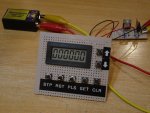Someone else asked this question earlier and no one answered so I'll ask it again. Which is harder on a diode, constant operation or pulsed? Igor said (correct me if I am mistaken) he thought it was the ON cycles that hurt it more, so running a diode for 100 hours in 1 minute cycles would degrade it more than 100 hours constantly. This would mean that pulsed operation would degrade it more, yes? But commercially they usually run them pulsed even when the device does not require it don't they?
This probably isn't a variable we want to change with second test, but it would be good to know for future tests. Any input is appreciated.
If the diode is turned ON and left ON without any switching, it can survive WAY longer than if it is turned ON and OFF.
Time would pass much faster, but the end result would not be anywhere near what a diode would survive in a laser pointer. Here we are simulating average laser pointer use.
The cycling adds to the suffering of the laser diode, by adding the power-up related stresses to the optical flux alone. Such as rapid changes in the die temperature.
The majority of times i killed a diode, it happened at a powerup. I would turn it on, and only see a blob - the diode did lase for a very short time, but tue do having been degraded, the power-up stresses and the optical flux pushed it over the edge.
A good example of this is the testing i did with some open can and long can reds - using a very slow powerup (ramping up the current by hand), i was able to push them above 400mW! With an instant power-up, the same diodes would die instantly at those currents.
Pulsing on the other hand is a completelly different for it. It does allow setting a diode to twice the power without shortening the life, but under very strict conditions, The maximum pulse width is usually limited to 30ns with a duty cycle of 50%.
And while the power is changing rapidly, the thermal stresses to the diode are not the same at every pulse, as they are at a normal CW powerup. Only the first pulse causes a similar stress, while with every next pulse, the heat in the diode just moves a bit up and down around a certain average point.
At least that is how i imagine it, i don't quite understand all the details of what happens inside the diode, but i know, it's the power-up's they don't like.
Optical flux at the die is a major factor in degradation, but power-up stresses play a big role as well.
If we were to cycle two completelly identical diodes side by side, one with a 1 minute cycle, the other with a five minute cycle, the five minute one would live longer - as long as there is no overheating involved with the 5 minute one of course (but there are no two identical diodes, it would take killing two groups to test this)...
EDIT:
Someone else asked this question earlier and no one answered so I'll ask it again. Which is harder on a diode, constant operation or pulsed?
Hmm, again i turned a simple question into a complicated answer.
Which is harder on the diode, CW or Pulsed.... It depends:
- If both CW and Pulsed are set to reach the same power, say 400mW CW vs. 400mW Pulsed, CW is WAY harder on the diode.
- If Pulsed is at twice the power of the CW, both are practically the same for the diode - in pulsed wave, the diode can reach twice the power without wasting lifetime, but only within the specified restrictions (pulse width and 50% duty cycle)...
Otherwise, i was working on the second torture chamber station today, now that i finally had some time, and i finished the counter setup for it. Now i just need to connect it to the second sensor, and rearrange the torture chamber a little bit, so it can accomodate two diodes.
I think it would make sense to start both the second 8x and the 12x experiment simultaneously, because i will have to re-plot them at regular intervals, and it would waste a lot less time, if this happens for both diodes every time i stop the cycler, instead of separatelly, since that could make the other diode wait and cause more delays....
Attached is a photo of the new counter with it's control panel, together with a new power supply for both counters (the old one needs 5V and the new one 3V) during testing.
I should be done with the Torture Chamber renovations tomorrow, so we need to reach a final decision for both diodes.




